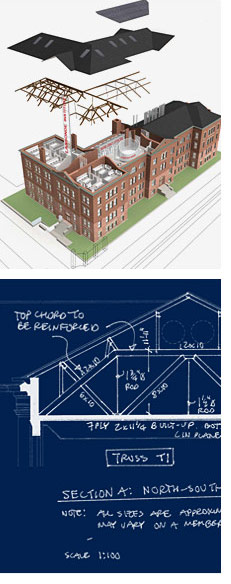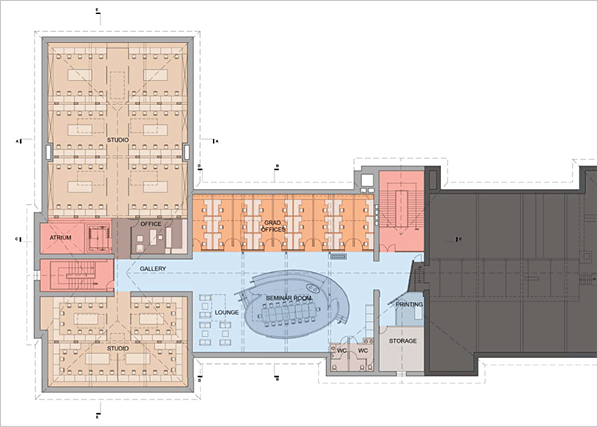 |
|---|
Projects in Planning
CivE Interdisciplinary Design Studios | Centre for Enabling Technologies Building | |

Interdisciplinary Design Studios within Civil Engineering and Lassonde Mining Institute
The Mining Building, located at the main gates of the University of Toronto at the corner of College Street and King’s College Road, is one of the original campus buildings. Its 100th anniversary was celebrated in 2005. It is home of one of the first U of T lecture theatres and the original home to the Canadian Mining Hall of Fame, which recognizes legendary explorers and miners who contributed to the growth and development of the Canadian mining industry. Today, the Mining Building hosts the Undergraduate Lassonde Mineral Engineering Program and the Lassonde Institute for Graduate Research in Engineering Geoscience as well as some MIE and IBBME offices.
We envision transforming this venerable structure by juxtaposing modern and historic elements to create a spectacular new space to address pressing needs for additional facilities to support undergraduate and graduate programs and research functions. The innovative and dynamic space envisioned well promote interdisciplinary activities and enhance the student learning experience.
The attic, currently unusable space, will be converted to provide interdisciplinary design studios within CivE and the Lassonde Mining Institute, graduate student offices, a seminar room and administrative space. The project will also include the installation of an elevator shaft and entrance at grade level at the west end to make the building fully accessible, a new roof with numerous skylights as part of the building-integrated photovoltaics, and cleaning and restoration of the exterior brick to its original colour. The renovated and restored Mining Building will give Canada’s mining business capitol a new education and research hub.

Centre for Enabling Technologies Building
A proposed Centre for Enabling Technologies (CET) is among a number of buildings for which the University of Toronto is seeking public funding. “Enabling” technology includes advanced materials, nanotechnology and photonics and has a wide variety of applications that include the automotive industry, healthcare, digital media and energy/environment initiatives. Research to be conducted in the new facility has the potential to create spin-off companies, licence agreements, and additional patents and disclosures. It will enhance the educational experience of our graduate students and contribute to their attraction and retention. Given Engineering’s clusters of CRC chairs and its position as the premier Engineering school in Canada and 10th in the world, a strong case is made for locating this new Centre here. Furthermore, we are already undertaking groundbreaking research in this field and need to consolidate and upgrade our facilities.
The proposed site of the CET is currently occupied by the Engineering Annex. While it is surrounded by other buildings and will therefore be a challenging site on which to build, it has the advantage of being pre-approved by the City. Construction can begin as soon as funding is confirmed. A multi-story building providing 6,000 net assignable square metres of space is envisaged that will include clean rooms, optics labs, materials characterization facilities and computer clusters. A project planning committee is working with potential users to define specific space requirements.
GB Engineering Registrar’s Office
Planning is currently underway to renovate the service counter area of the Registrar’s Office in order to meet current student needs, as well as to improve the use of space. The existing counters and adjacent support space are not configured for optimal usage and will be replaced with a modular-furniture system solution, eliminating the raised podium. In conjunction with this work and following the relocation of the Dean’s Office to the Bahen Centre, other student-oriented services will be consolidated on the first floor of the Galbraith Building for increased visibility and accessibility. Work is scheduled to begin in mid-summer and progress into the fall of this year.